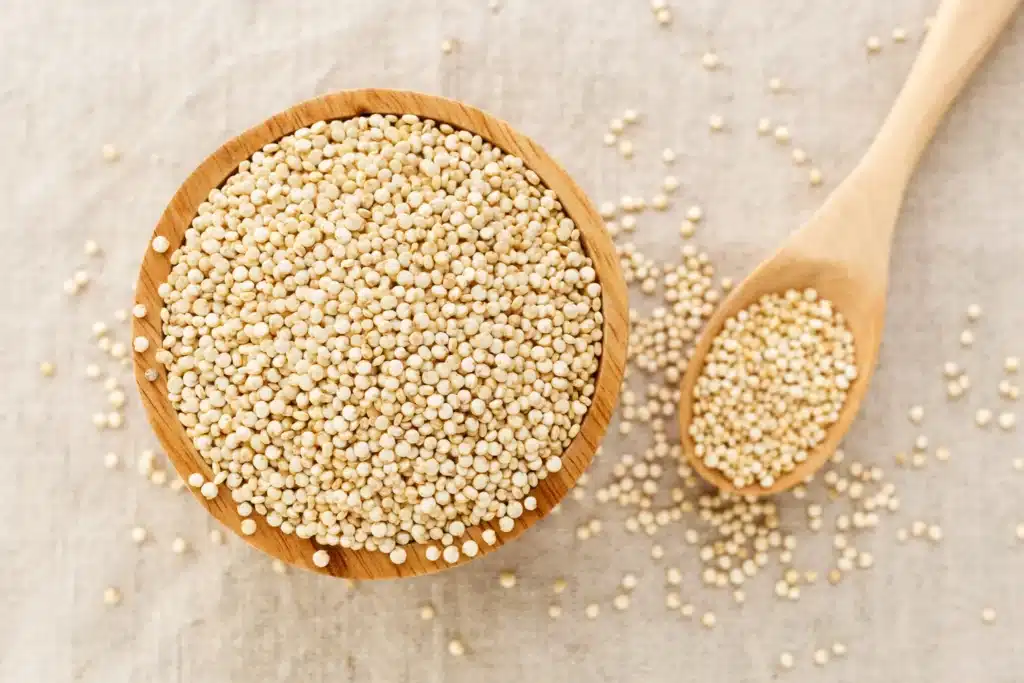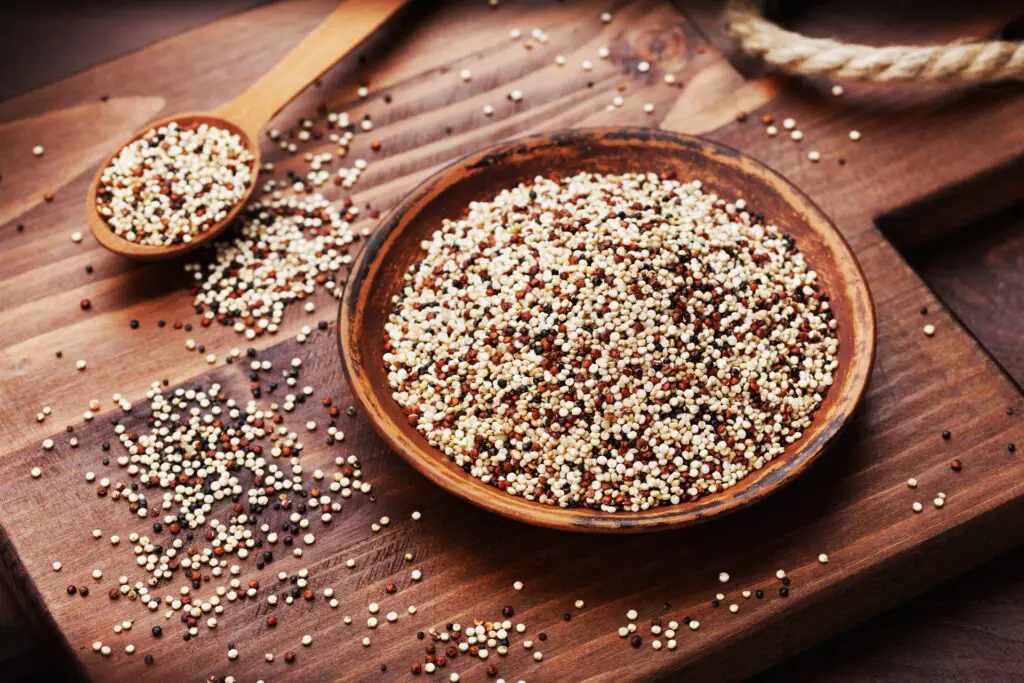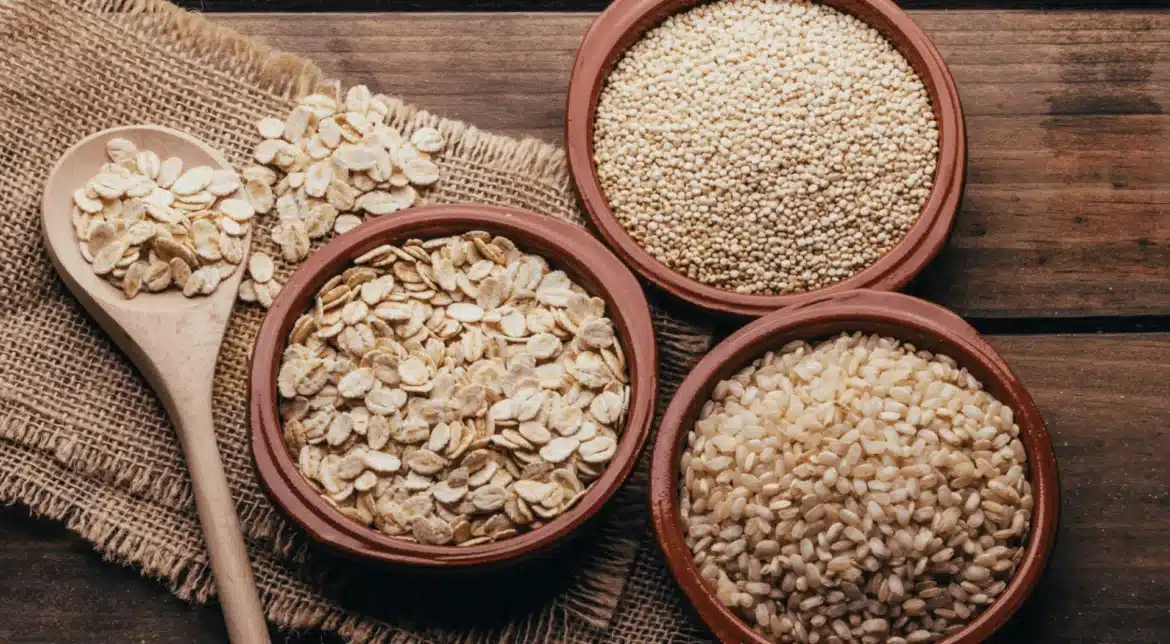Introduction
How Much Quinoa To Eat Per Day For Weight Loss: Quinoa, pronounced keen-wah, is a grain-like seed that has been cultivated for thousands of years in South America, particularly in the Andean region. It stands out as a nutritional powerhouse, packed with essential nutrients, such as protein, fiber, vitamins, and minerals. Its rich nutrient profile has earned it a reputation as a versatile and healthy food that not only supports weight management but also contributes to overall well-being.
Weight loss is a multifaceted endeavor that involves a combination of factors, including diet, exercise, and lifestyle choices. While there is no magic bullet for shedding excess pounds, incorporating quinoa into your daily meals can be a valuable part of a holistic weight loss strategy. Quinoa’s unique combination of high-quality protein and dietary fiber makes it a satiating choice, helping you feel fuller for longer and potentially reducing overall calorie intake. Low glycemic index can help stabilize blood sugar levels, reducing cravings for unhealthy snacks.
It’s essential to consider your individual needs, goals, and overall dietary plan. Factors like your age, gender, activity level, and calorie requirements play a crucial role in determining the optimal quinoa intake. Portion control and mindful eating are key principles to bear in mind when incorporating quinoa into your weight loss regimen.

How much quinoa should I eat to lose weight?
This may promote weight loss. A 2017 study stated that consumption of 50 g of quinoa daily may lower triglycerides in obese individuals and may reduce the occurrence of metabolic syndrome (a group of conditions that increase the risk of heart disease, stroke, and diabetes).
The appropriate portion size of quinoa for weight loss can vary depending on your individual needs, activity level, and overall calorie intake. However, a general guideline is to consume about ½ to 1 cup of cooked quinoa per meal. This portion size provides enough protein and fiber to keep you satisfied without overloading your calorie intake.
Measure Portions: Invest in a kitchen scale or measuring cups to accurately portion your cooked quinoa. This ensures you’re not inadvertently consuming excessive calories.
Balance with Vegetables: Combine quinoa with a variety of vegetables to create a balanced and filling meal. Vegetables are low in calories but high in nutrients, adding volume to your plate without excess calories.
Control Condiments: Be mindful of the condiments and toppings you use with quinoa. Opt for healthier options like olive oil, lemon juice, and herbs instead of calorie-laden sauces or dressings.
Monitor Total Calorie Intake: While quinoa is nutritious, it’s to consider your overall calorie intake. Ensure that your total daily calories align with your weight loss goals.
Is 1 cup of quinoa too much?
You can eat one-two cups of cooked quinoa in a day. You should avoid eating it if you experience stomachache, itchiness or vomiting after consuming it. A study by Harvard Public School of Health has reported that eating a bowl of quinoa daily is healthy and without any side effects.
Calorie Goals: Your daily caloric needs depend on your age, gender, activity level, and weight management goals. If a 1-cup serving of quinoa aligns with your daily caloric goals and doesn’t exceed your total caloric intake, it can be an appropriate portion.
Nutritional Balance: Consider the overall nutritional balance of your meal. Combine quinoa with a variety of vegetables, lean proteins, and healthy fats to create a balanced and nutritious meal.
Individual Needs: Some individuals may require larger portions based on their energy expenditure, metabolism, and overall dietary plan. Athletes or those with higher caloric needs may find 1 cup of quinoa suitable for a meal.
Satiety and Fullness: Quinoa’s protein and fiber content contribute to feelings of fullness and satiety. Adjust the portion based on how satisfied you feel after consuming it.
Dietary Goals: If you’re using quinoa as a primary source of protein or if you follow a plant-based diet, your portion size might be higher to meet your protein needs.
Does quinoa burn belly fat?
That’s because it’s what is known as a complete grain, combining protein, fibre, B vitamins and complex carbohydrates all in one. Eating grains like quinoa will help to boost your metabolism, and burn belly fat faster, as will.
Satiety: Thanks to its protein and fiber content, quinoa can help you feel full and satisfied, potentially reducing overall calorie consumption.
Stabilizing Blood Sugar: Its low glycemic index can help prevent the blood sugar fluctuations that often lead to cravings and overeating.
Balanced Nutrition: Quinoa provides nutrients while being relatively low in calories, making it a nutritious choice in a calorie-controlled diet.
Reducing Processed Foods: Substituting processed grains with quinoa can contribute to better overall nutrition and potentially aid in weight loss.
Is it OK to eat quinoa every day?
As per the report, adding quinoa to daily diet patterns is healthy and safe. However, consuming a single type of quinoa meal in an extreme ratio can lead to gut swelling or cramping. But it happens when you consume more than your body required.
Complete Protein Source: Quinoa is unique among plant-based foods because it provides all nine essential amino acids, making it a complete protein source. This makes it particularly valuable for vegetarians and vegans.
High in Fiber: Quinoa is rich in dietary fiber, which aids digestion, helps maintain regular bowel movements, and promotes feelings of fullness and satiety.
Vitamins and Minerals: Quinoa contains various essential nutrients, including magnesium, potassium, phosphorus, iron, and several B vitamins. These nutrients are crucial for overall health and well-being.
Low Glycemic Index: Quinoa has a low glycemic index, meaning it has a minimal impact on blood sugar levels. This makes it suitable for those concerned about blood sugar control.
Can I eat 1 cup of quinoa a day?
“One can eat one-two cups of cooked quinoa in a day. Also, one should avoid eating quinoa if he/she experiences stomach ache, itchiness or vomiting after consuming it. That person may have a quinoa allergy,” suggests Ms Chopra.
Nutrient Intake: Consuming 1 cup of quinoa daily can ensure you receive a consistent and substantial dose of essential nutrients, promoting overall health.
Satiety: The high protein and fiber content of quinoa can help keep you feeling full and satisfied, potentially reducing overall calorie intake and aiding in weight management.
Versatility: Quinoa is incredibly versatile and can be incorporated into a wide range of dishes, allowing you to enjoy a diverse and nutritious diet.
Gluten-Free Option: Quinoa is naturally gluten-free, making it a safe and nutritious choice for individuals with gluten sensitivities or celiac disease.
Is 1 cup of quinoa enough for 2 people?
Theportion per person is ¼ cup of uncooked quinoa or ¾ cup of cooked quinoa if served as a side dish. If you need to make 2 cups of cooked quinoa for a recipe, cook ⅔ cup of dry quinoa with 1 cup of water.
Intended Use: The first consideration when determining if 1 cup of quinoa is enough for two people is how you plan to use it. If you intend to use the quinoa as a side dish or base for a larger meal, 1 cup may be sufficient.
Appetite: Individual appetites vary, so it’s essential to consider the hunger levels and dietary preferences of the people you are serving. Some individuals may be satisfied with smaller portions, while others may require more substantial servings.
Accompaniments: The quantity of quinoa needed can also depend on what you plan to serve alongside it. If you’re preparing a quinoa salad with plenty of vegetables and protein sources like beans or tofu, a smaller portion of quinoa may suffice.
Dish Type: Consider the type of dish you are preparing. For example, if you are making a hearty quinoa-based stew or casserole, you may need less quinoa per person compared to a light salad or side dish.
Nutritional Needs: Take into account the nutritional needs of the individuals you are serving. Quinoa is a nutritious grain, but it’s essential to ensure that everyone is receiving an adequate amount of protein, fiber, and other nutrients.
How much is 2 cups cooked quinoa?
2/3 cup
Since quinoa increases 3 times when cooked, divide the cooked volume by three. 2/3 cup dry quinoa = 2 cups cooked quinoa.
Start with Uncooked Quinoa: Keep in mind that the volume of quinoa increases significantly when cooked. You will need to start with uncooked quinoa to prepare the desired amount.
Use the Right Ratio: The standard ratio for cooking quinoa is 2 parts water to 1 part quinoa. This means that for 2 cups of cooked quinoa, you’ll need 1 cup of uncooked quinoa.
Rinse the Quinoa: Before cooking, rinse the quinoa thoroughly in a fine-mesh sieve to remove any bitter saponins that may be present.
Cook the Quinoa: In a saucepan, combine 1 cup of rinsed quinoa with 2 cups of water. Bring to a boil, then reduce the heat to low, cover, and simmer for about 15 minutes, or until the quinoa has absorbed the liquid and is tender. Fluff it with a fork and let it cool slightly.
Measure the Cooked Quinoa: Once cooked and slightly cooled, measure out 2 cups of the cooked quinoa using a dry measuring cup.
What is 1 cup of quinoa?
One cup of cooked quinoa weighing 185 grams (g) provides 8.14 g of protein. The proteins in quinoa offer a wide range of amino acids . Amino acids are vital for supporting muscle development and immune activity, among other essential functions.
Measuring 1 Cup of Uncooked Quinoa
Use a Dry Measuring Cup: Ensure you have a dry measuring cup, which is designed for dry ingredients like grains. It typically has a flat edge for leveling the contents.
Scoop Quinoa: Gently scoop the uncooked quinoa into the measuring cup. Do not pack it down or tap the cup, as this can result in an inaccurate measurement.
Level Off: Once the measuring cup is full, use a flat edge (like the back of a knife or a spatula) to level off the quinoa. This ensures that you have an accurate 1-cup measurement.
Culinary Uses for 1 Cup of Cooked Quinoa
Quinoa Salad: Toss cooked quinoa with vegetables, herbs, and your favorite dressing to make a delicious and nutritious salad.
Grain Bowl: Build a hearty grain bowl by layering cooked quinoa with roasted or sautéed vegetables, proteins like grilled chicken or tofu, and a flavorful sauce.
Side Dish: Serve cooked quinoa as a side dish to accompany main courses like roasted meats or fish.
Breakfast Porridge: Simmer cooked quinoa with milk (dairy or plant-based), sweeten with honey or maple syrup, and top with fruits, nuts, or seeds for a hearty breakfast porridge.

Conclusion
Determining how much quinoa to eat per day for weight loss is a personalized journey that should align with your specific dietary needs, preferences, and weight loss goals. Quinoa, as a nutrient-dense superfood, offers a wide array of health benefits that can support your weight management efforts. However, it’s essential to strike a balance and not rely solely on quinoa for weight loss, as a well-rounded approach that includes exercise, portion control, and overall dietary choices is crucial.
If you have specific weight loss goals or dietary concerns, consider consulting a registered dietitian or nutritionist who can provide personalized guidance based on your unique needs. That quinoa is just one component of a healthy diet and weight loss plan. A holistic approach, including regular physical activity and a variety of nutrient-rich foods, is essential for sustainable and effective weight management.
Incorporating quinoa into your daily meals can be a delicious and nutritious way to support your weight loss journey. By making informed choices and being mindful of portion sizes, you can harness the benefits of this superfood while moving closer to your health and fitness goals. Ultimately, the key to successful weight loss is finding a dietary approach that suits your lifestyle and preferences while promoting a balanced and sustainable relationship with food.

